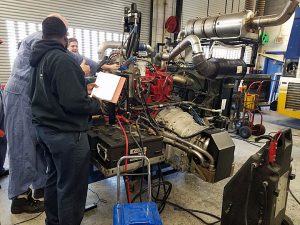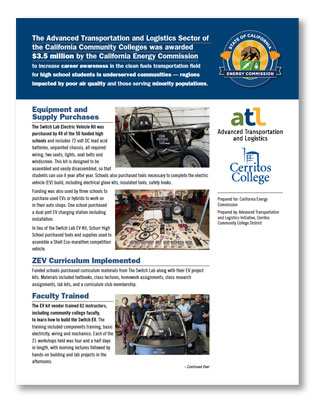
 Meeting Critical Needs of Municipal Transportation Systems
Meeting Critical Needs of Municipal Transportation Systems
The Southern California Regional Transit Training Consortium (SCRTTC) is a non-profit organization comprised of transit agencies, community colleges, universities and private industry partners.
The SCRTTC recently facilitated California Energy Commission (CEC) funding in order to provide training to transit employees across the state, meeting some of the most critical needs faced by municipal transportation systems.
The SCRTTC obtained the funding through a Memorandum of Understand (MoU) with San Diego Miramar College, a founding academic member of the SCRTTC, which used the SCRTTC’s annual transit industry training needs assessment to pinpoint the highest priority training issues in the most cost effective manner.
“It’s always good to validate from the transits exactly what their training priorities are rather than making assumptions, especially when you consider how rapidly the transit technologies are advancing,” said SCRTTC Training Director Nina Babiarz. “These CEC funds help us to hit the transit highest training priorities.”
 125 transit employees from Santa Monica to Sacramento participated in this CEC funded training from last December through June. Training topics included both compressed natural gas engines and transit electrical systems training delivered both on-line and in the classroom for hands-on application.
125 transit employees from Santa Monica to Sacramento participated in this CEC funded training from last December through June. Training topics included both compressed natural gas engines and transit electrical systems training delivered both on-line and in the classroom for hands-on application.
Team-Developed Courses
All of the SCRTTC’s training courses are developed with a team represented by both transit subject matter experts in collaboration with community college instructor’s academic acumen. The consortium approach allows transit agencies across the region to receive consistent training that meets transit standards without wasting resources on developing many redundant, individual programs.
“Just about every transit agency in California has a community college around the corner, and each were individually coming to their local community college for training,” Babiarz pointed out. “This collaborative approach enabled a regional solution to be shared by many with the same or similar problems. It makes for a very cost effective learning model.”
The result of the consortium approach is a library of dozens of courses that provide an industry-wide, ready resource just waiting to be delivered. This decreases the development costs for all. The SCRTTC works to ensure their instructors delivering training across the region are equipped to do so by conducting Train-the-Trainer sessions. With the current rate of retirements, this increases and replenishes the SCRTTC’s instructor pool, while keeping community college instructors abreast of transit industry technological developments.
At the end of each quarter each transit agency receives a report from the SCRTTC with a customized summary of the training completed by their technicians.
The Challenge: Keeping Current
A constant challenge for SCRTTC is keeping current with the transit training needs required as California continues to be a leader in renewable and alternative energy. With the era of federal earmarks long gone, Babiarz said state funding has become more important than ever to pay for workforce development and essential training.
“California is the first in the country to develop and deliver some of this training for zero emission and alternatively fueled transit buses. Safety is of paramount concern when employees are working on highly compressed gases and high voltage vehicles. It’s simply not safe without proper training,” Babiarz said. “This training would not have taken place without CEC funding. We knew the money would be well spent.”



